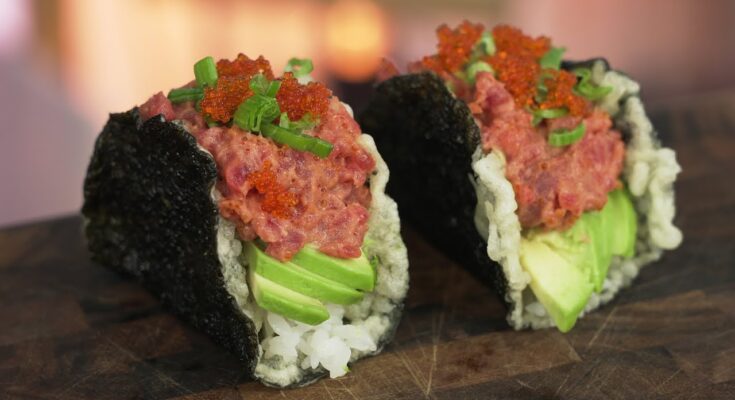Tuna Tartare Recipe: Tuna tartare is the epitome of elegance in simplicity. This raw tuna dish, often served as an appetizer in high-end restaurants, is a refreshing and flavorful way to enjoy seafood without much cooking fuss. Originating from French cuisine but adapted globally, tuna tartare is celebrated for its delicate texture, bright flavor, and aesthetic appeal. If you’ve ever had sushi or sashimi and loved it, you’re bound to fall in love with tartare.
Unlike heavily spiced or cooked fish dishes, tuna tartare keeps things minimal—highlighting the freshness of the tuna and pairing it with complementary ingredients like citrus, soy sauce, sesame oil, and avocado. It’s a dish you can serve at a dinner party to impress, or even whip up as a healthy, protein-rich lunch for yourself.
What makes it extra special? It’s a no-cook dish that requires minimal prep time—just fresh ingredients and attention to detail.
Choosing the Right Tuna
Sushi-Grade Tuna: What You Need to Know
When making tuna tartare, quality is everything. You’re eating the fish raw, so it’s crucial to choose sushi-grade or sashimi-grade tuna. This classification means the tuna was frozen at a specific temperature shortly after being caught, killing off parasites and ensuring it’s safe for raw consumption.
Yellowfin (Ahi) and Bluefin tuna are common choices. Yellowfin offers a leaner texture with a mild flavor, while Bluefin is richer and more buttery. Whichever you pick, the freshness must be top-tier. Avoid tuna with a fishy smell, dull color, or mushy texture.
Where to Buy Fresh Tuna
Your best bet for high-quality tuna? A trusted fishmonger or Asian grocery store with a good seafood section. Whole Foods, local Japanese markets, or online retailers like Fulton Fish Market often carry sushi-grade tuna. Always ask the seller if it’s suitable for raw consumption.
Planning a dinner party? Call ahead to make sure they have fresh stock, as sushi-grade tuna often sells out quickly.
Essential Ingredients for Tuna Tartare
Ingredient List Breakdown
Here’s what you’ll typically need for a classic tuna tartare:
- Sushi-grade tuna (about 8 oz)
- Avocado (ripe but firm)
- Soy sauce (low sodium is preferred)
- Sesame oil (toasted for that nutty aroma)
- Fresh lime or lemon juice
- Scallions or chives
- Fresh ginger (finely grated)
- Garlic (optional, finely minced)
- Salt & pepper
- Chili flakes or sriracha (for heat)
- Sesame seeds (for garnish)
- Cucumber slices or wonton crisps (for serving)
These ingredients combine to create a balance of creamy, tangy, salty, and spicy flavors—all while highlighting the natural sweetness of the tuna.
Flavor Profile and Customizations
Want to add a twist? You can mix in ingredients like:
- Wasabi for a sinus-clearing kick.
- Ponzu sauce for a citrusy umami boost.
- Mango or pineapple for sweetness.
- Cilantro if you like a herbaceous note.
Don’t be afraid to experiment—just remember to let the tuna shine.
Step-by-Step Preparation Guide
Step 1: Prepping the Tuna
Start by patting the tuna dry with paper towels. Use a sharp knife to dice it into small, uniform cubes—around ¼ inch. This size gives the perfect texture: not too mushy, not too chewy.
Pro tip: Pop the tuna in the freezer for about 10–15 minutes before slicing. It firms up, making it easier to cut cleanly.
Place the diced tuna in a chilled bowl, then cover and refrigerate until you’re ready to mix in the other ingredients. Keeping it cold maintains freshness and texture.
Step 2: Mixing the Marinade
In a separate bowl, combine 2 tablespoons of soy sauce, 1 teaspoon of sesame oil, a teaspoon of lime juice, and a bit of grated ginger. Add chili flakes or sriracha if you like heat.
Taste it before mixing with the tuna. Adjust acidity, saltiness, or spice levels to your liking. The goal is to create a balanced marinade that enhances the tuna, not overpowers it.
Step 3: Combining Ingredients
Take the tuna out of the fridge and pour the marinade over it. Gently mix with a spoon or spatula, being careful not to break down the tuna pieces. Add diced avocado and scallions, folding them in gently.
Let it sit for 5 minutes so the flavors meld. Avoid marinating too long—this isn’t ceviche. You want the fish fresh, not cooked in acid.
Step 4: Plating Like a Pro
Use a round mold or ramekin to shape the tartare on a chilled plate. Garnish with sesame seeds, microgreens, or thinly sliced radishes. Serve alongside crispy wonton chips, cucumber rounds, or even a seaweed salad.
Presentation matters! A neat, colorful plate makes your tartare restaurant-worthy.
Tips for the Perfect Tuna Tartare
Chef Secrets and Common Mistakes to Avoid
Creating the perfect tuna tartare is more about finesse than fancy techniques. One of the biggest chef secrets is to keep everything chilled—from your bowl to your knife to the plate you’ll serve it on. Why? Because warm temperatures can change the texture and flavor of raw fish quickly.
Another important tip is using a very sharp knife. A dull blade can tear the tuna, giving it a mushy texture that ruins the whole experience. Precision cuts help the tuna retain its form and mouthfeel.
Avoid these common mistakes:
- Over-marinating the fish: This isn’t ceviche. Leaving tuna in citrus or soy sauce for too long will start to “cook” it, affecting its texture and making it chewy.
- Overmixing: Tuna should be folded gently with other ingredients to avoid breaking down the delicate cubes.
- Adding salt too early: Soy sauce is salty enough. Always taste the marinade before adding extra salt.
- Using poor-quality tuna: This is the star of your dish. If it’s not sushi-grade, skip it. Safety and flavor go hand in hand.
A final touch? Garnish wisely. Microgreens, edible flowers, or even just a few dots of spicy mayo can elevate the presentation without overwhelming the flavor.
Nutritional Benefits of Tuna Tartare
Tuna tartare isn’t just delicious—it’s a powerhouse of nutrition. Packed with lean protein, omega-3 fatty acids, and essential vitamins like B12 and D, it’s one of the healthiest raw dishes you can enjoy.
Here’s a quick breakdown of the health perks:
- Low in fat but high in heart-healthy omega-3s
- Excellent source of protein (perfect for muscle repair and energy)
- Rich in selenium, a key antioxidant
- High in Vitamin B12, essential for red blood cell formation
- Contains potassium and magnesium, supporting heart and brain health
Plus, if you’re keeping an eye on calories or carbs, tuna tartare is a great choice. Without the need for rice (like in sushi) or bread, it’s low-carb and keto-friendly. And with ingredients like avocado, you get healthy fats that keep you full longer.
Of course, like with any raw dish, moderation and freshness are key. Stick with reputable sources and enjoy tuna tartare as part of a balanced diet.
Pairing Suggestions
Best Drinks and Sides to Serve With It
Pairing your tuna tartare with the right drink or side dish can elevate your dining experience to the next level. Since the dish has delicate, clean flavors with a bit of citrus and umami, go for pairings that complement without overpowering.
Drink pairings:
- Dry white wines like Sauvignon Blanc or Pinot Grigio are a natural match. Their crisp acidity enhances the freshness of the tartare.
- Sparkling wines add a celebratory feel while cleansing the palate.
- Light beers, especially those with citrus notes, work well with the dish’s flavors.
- Sake is a classic pairing. Choose a chilled, dry sake for balance.
- Cocktails like a gin and tonic with cucumber or a yuzu martini can add a refreshing zing.
Side dish suggestions:
- Seaweed salad brings in umami and complements the oceanic vibe.
- Crispy wonton chips or plantain chips offer a crunchy contrast.
- Cucumber slices, pickled ginger, or edamame make light, refreshing sides.
- For something heartier, serve with a small portion of jasmine rice or a poke-style bowl.
Whatever you choose, keep it light and let the tuna tartare shine.
Variations You’ll Love
Spicy Tuna Tartare
If you love a bit of heat, spicy tuna tartare might be your new favorite. Just add:
- 1 tsp sriracha or sambal oelek
- A dash of chili oil or wasabi
- Optional: finely chopped jalapeño
Mix these into your marinade or blend them with a dollop of mayo for a spicy creamy sauce to drizzle over the top.
Spicy tuna tartare brings a bold twist while keeping the classic essence. It’s perfect for those who enjoy sushi rolls with a kick.
Avocado Tuna Tartare
Avocado and tuna are a match made in culinary heaven. This version layers mashed or diced avocado beneath or within the tartare. Here’s a quick combo:
- Dice half an avocado and gently fold it in with the tuna mixture.
- Or, mash avocado with lime juice, salt, and pepper as a base layer.
You get that creamy texture with a buttery taste that balances the bright acidity of the marinade. Add some radish slices or sprouts on top, and you’ve got a super Instagram-worthy plate.
Storing and Serving Tuna Tartare
Serving tuna tartare fresh is non-negotiable. This dish thrives on immediacy—its texture, flavor, and safety all hinge on how quickly you serve it after preparation. Ideally, tuna tartare should be consumed within an hour of being made, and it must be kept cold at all times.
If you’re preparing it for a party or dinner event, make the marinade and dice the tuna in advance, but only combine them right before serving. You can store the cut tuna separately in an airtight container in the fridge for up to 24 hours, although the fresher, the better. Be sure to keep it on ice if you’re prepping multiple portions for guests.
Never leave tuna tartare at room temperature for more than 2 hours. Raw fish spoils quickly, especially in warm environments, and the risk of foodborne illness increases significantly. If you’re serving outdoors, consider using a chilled serving plate or placing the plate over a bed of ice.
As for leftovers—tuna tartare doesn’t keep well. Once marinated, the tuna starts to break down, and the texture degrades. If you absolutely must store leftovers, keep them tightly sealed in the refrigerator and consume them within 12 hours. But honestly, this dish is best enjoyed in one sitting.
For serving, always chill your plates beforehand. Use ring molds to shape the tartare into perfect rounds for a restaurant-style presentation. Garnish with sesame seeds, microgreens, or a small drizzle of flavored oil for that extra wow factor. If you want a more casual setup, serve the tartare in a bowl alongside crispy chips or cucumber rounds for scooping.
FAQs about Tuna Tartare Recipe
Is raw tuna safe to eat?
Yes, as long as it’s sushi-grade or sashimi-grade tuna. These have been frozen at specific temperatures to kill parasites and are considered safe for raw consumption.
Can I make tuna tartare ahead of time?
You can prep the components in advance (like dicing the tuna and making the marinade), but combine them just before serving to preserve texture and freshness.
What tuna is best for tartare?
Yellowfin (Ahi) and Bluefin tuna are the most popular choices. Make sure it’s labeled sushi-grade and purchased from a reputable source.
How long can tuna tartare sit out?
No more than 2 hours at room temperature. Keep it chilled or over ice if serving in warm conditions.
Can I freeze tuna tartare?
It’s not recommended. Freezing changes the texture of the fish, and once it’s been marinated, freezing and thawing can ruin the dish.
Conclusion
Tuna tartare is more than just a trendy dish—it’s a celebration of fresh, high-quality ingredients and minimalist culinary technique. Whether you’re crafting it for a romantic dinner, a group gathering, or a personal treat, it never fails to impress.
With its rich yet clean flavor, versatility in preparation, and impressive health benefits, tuna tartare earns its place at the top of the raw seafood favorites. The key is sourcing the best tuna you can find and respecting the balance of the flavors. From the first careful dice of the tuna to the final sprinkle of sesame seeds, each step is part of a simple ritual that results in something truly special.
So next time you want to shake things up in the kitchen—or wow your guests with minimal effort—this is your go-to recipe. It’s elegant, easy, and unforgettable.



